Innovation and Commercialisation Report: Unilever Case Study
VerifiedAdded on 2023/01/03
|11
|3150
|24
Report
AI Summary
This report provides a comprehensive analysis of innovation and commercialisation strategies, using Unilever as a case study. It begins by defining innovation and comparing it to invention, highlighting their importance to organizations. The report then explores how organizational vision, leadership, culture, and teamwork shape innovation and commercialization. It delves into the 4 Ps of innovation, the use of innovation funnels, and the development of frugal innovation. Furthermore, it examines the effectiveness of commercial funnels, new product development procedures, and the creation of business cases for innovation, including funding sources. Finally, the report discusses tools for protecting intellectual property. The report covers various aspects of innovation, from theoretical concepts to practical applications within a global company context.
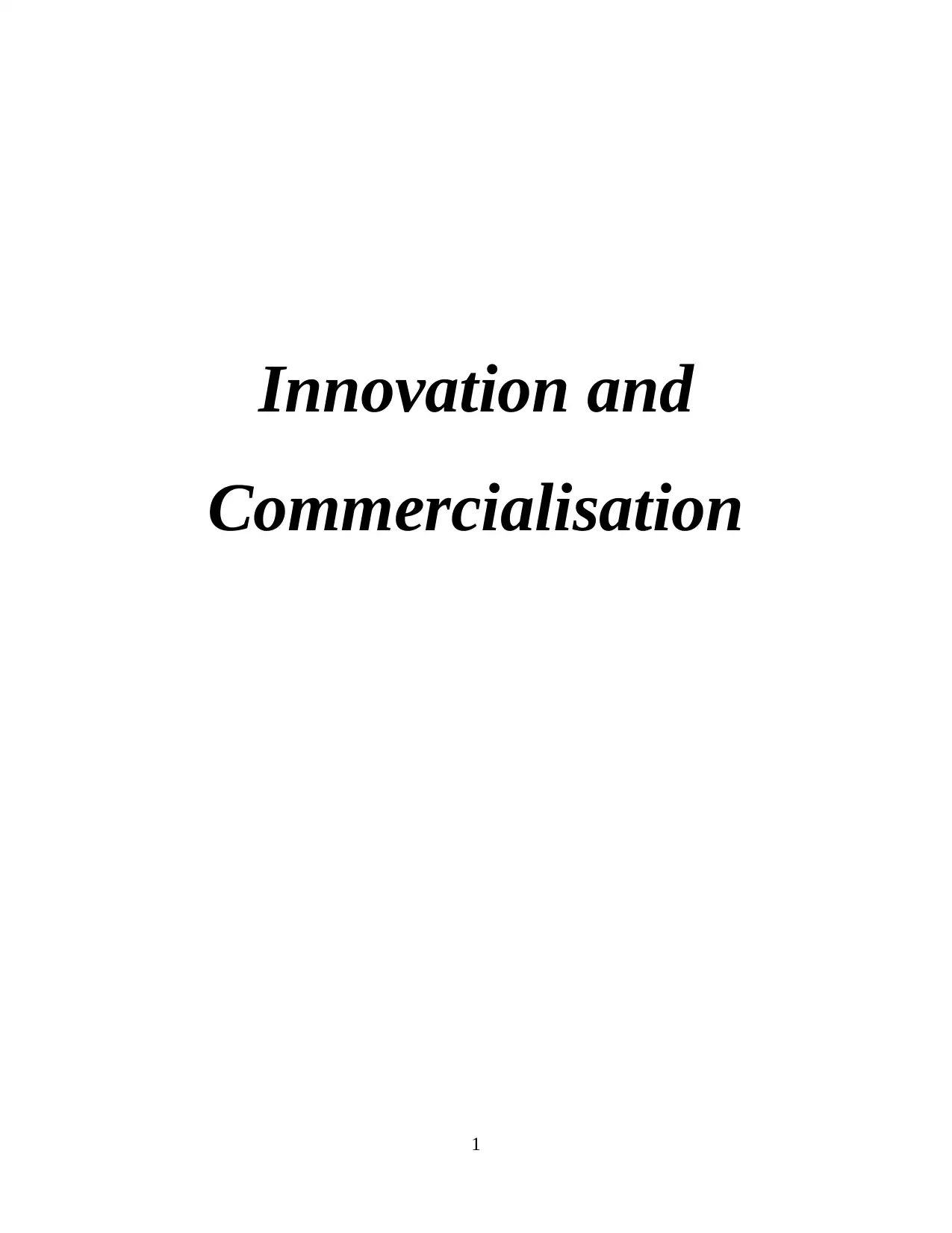
Innovation and
Commercialisation
1
Commercialisation
1
Paraphrase This Document
Need a fresh take? Get an instant paraphrase of this document with our AI Paraphraser
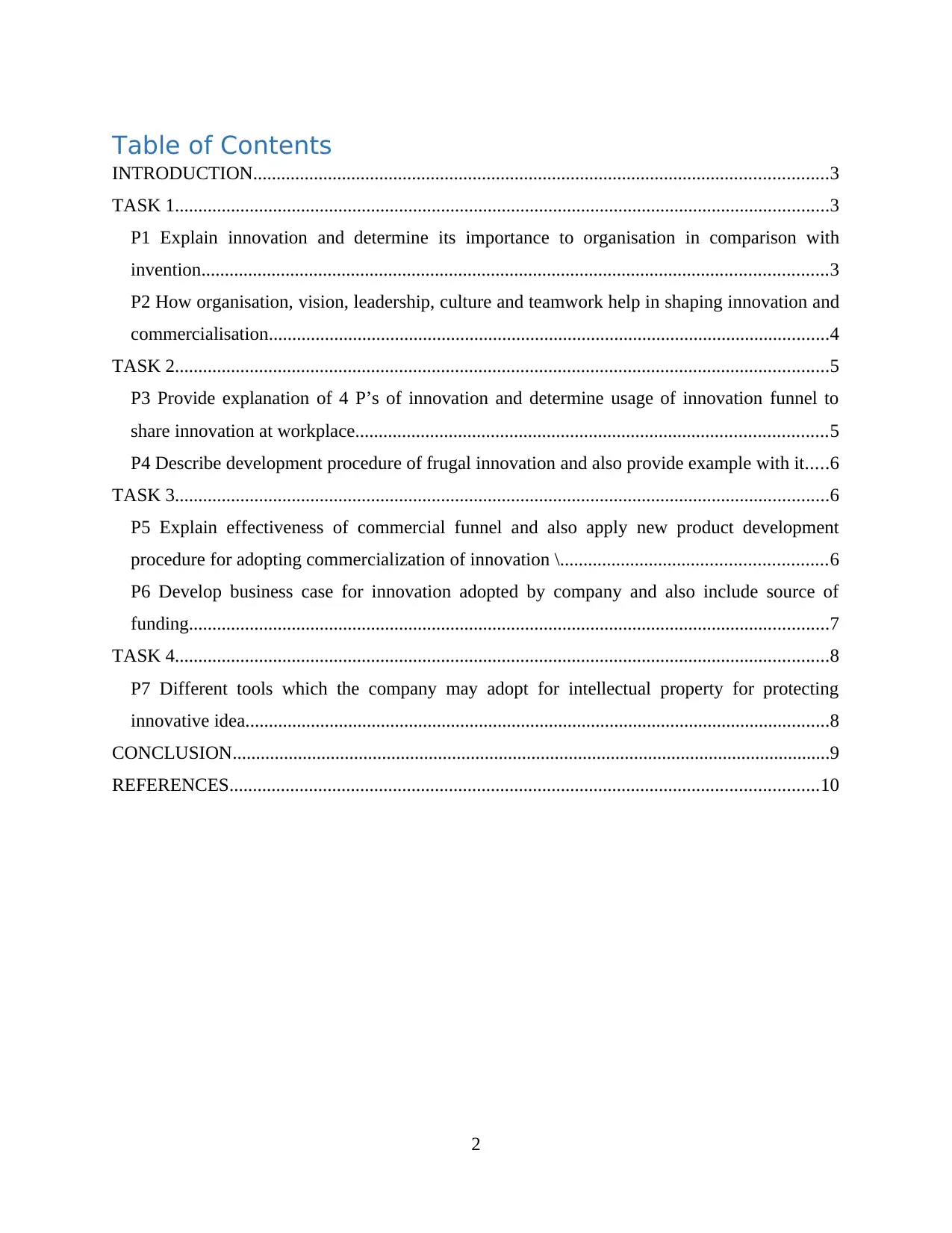
Table of Contents
INTRODUCTION...........................................................................................................................3
TASK 1............................................................................................................................................3
P1 Explain innovation and determine its importance to organisation in comparison with
invention......................................................................................................................................3
P2 How organisation, vision, leadership, culture and teamwork help in shaping innovation and
commercialisation........................................................................................................................4
TASK 2............................................................................................................................................5
P3 Provide explanation of 4 P’s of innovation and determine usage of innovation funnel to
share innovation at workplace.....................................................................................................5
P4 Describe development procedure of frugal innovation and also provide example with it.....6
TASK 3............................................................................................................................................6
P5 Explain effectiveness of commercial funnel and also apply new product development
procedure for adopting commercialization of innovation \.........................................................6
P6 Develop business case for innovation adopted by company and also include source of
funding.........................................................................................................................................7
TASK 4............................................................................................................................................8
P7 Different tools which the company may adopt for intellectual property for protecting
innovative idea.............................................................................................................................8
CONCLUSION................................................................................................................................9
REFERENCES..............................................................................................................................10
2
INTRODUCTION...........................................................................................................................3
TASK 1............................................................................................................................................3
P1 Explain innovation and determine its importance to organisation in comparison with
invention......................................................................................................................................3
P2 How organisation, vision, leadership, culture and teamwork help in shaping innovation and
commercialisation........................................................................................................................4
TASK 2............................................................................................................................................5
P3 Provide explanation of 4 P’s of innovation and determine usage of innovation funnel to
share innovation at workplace.....................................................................................................5
P4 Describe development procedure of frugal innovation and also provide example with it.....6
TASK 3............................................................................................................................................6
P5 Explain effectiveness of commercial funnel and also apply new product development
procedure for adopting commercialization of innovation \.........................................................6
P6 Develop business case for innovation adopted by company and also include source of
funding.........................................................................................................................................7
TASK 4............................................................................................................................................8
P7 Different tools which the company may adopt for intellectual property for protecting
innovative idea.............................................................................................................................8
CONCLUSION................................................................................................................................9
REFERENCES..............................................................................................................................10
2
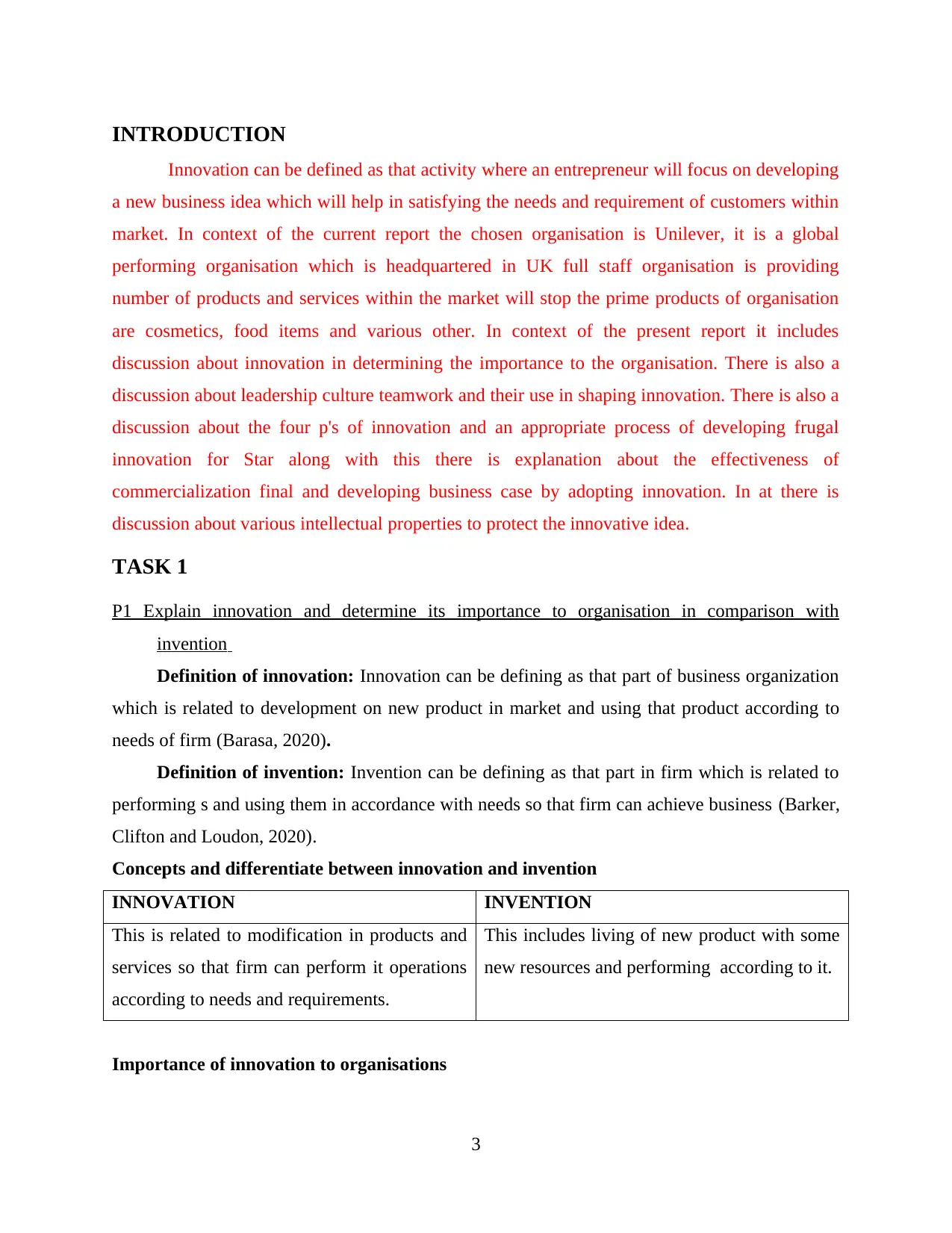
INTRODUCTION
Innovation can be defined as that activity where an entrepreneur will focus on developing
a new business idea which will help in satisfying the needs and requirement of customers within
market. In context of the current report the chosen organisation is Unilever, it is a global
performing organisation which is headquartered in UK full staff organisation is providing
number of products and services within the market will stop the prime products of organisation
are cosmetics, food items and various other. In context of the present report it includes
discussion about innovation in determining the importance to the organisation. There is also a
discussion about leadership culture teamwork and their use in shaping innovation. There is also a
discussion about the four p's of innovation and an appropriate process of developing frugal
innovation for Star along with this there is explanation about the effectiveness of
commercialization final and developing business case by adopting innovation. In at there is
discussion about various intellectual properties to protect the innovative idea.
TASK 1
P1 Explain innovation and determine its importance to organisation in comparison with
invention
Definition of innovation: Innovation can be defining as that part of business organization
which is related to development on new product in market and using that product according to
needs of firm (Barasa, 2020).
Definition of invention: Invention can be defining as that part in firm which is related to
performing s and using them in accordance with needs so that firm can achieve business (Barker,
Clifton and Loudon, 2020).
Concepts and differentiate between innovation and invention
INNOVATION INVENTION
This is related to modification in products and
services so that firm can perform it operations
according to needs and requirements.
This includes living of new product with some
new resources and performing according to it.
Importance of innovation to organisations
3
Innovation can be defined as that activity where an entrepreneur will focus on developing
a new business idea which will help in satisfying the needs and requirement of customers within
market. In context of the current report the chosen organisation is Unilever, it is a global
performing organisation which is headquartered in UK full staff organisation is providing
number of products and services within the market will stop the prime products of organisation
are cosmetics, food items and various other. In context of the present report it includes
discussion about innovation in determining the importance to the organisation. There is also a
discussion about leadership culture teamwork and their use in shaping innovation. There is also a
discussion about the four p's of innovation and an appropriate process of developing frugal
innovation for Star along with this there is explanation about the effectiveness of
commercialization final and developing business case by adopting innovation. In at there is
discussion about various intellectual properties to protect the innovative idea.
TASK 1
P1 Explain innovation and determine its importance to organisation in comparison with
invention
Definition of innovation: Innovation can be defining as that part of business organization
which is related to development on new product in market and using that product according to
needs of firm (Barasa, 2020).
Definition of invention: Invention can be defining as that part in firm which is related to
performing s and using them in accordance with needs so that firm can achieve business (Barker,
Clifton and Loudon, 2020).
Concepts and differentiate between innovation and invention
INNOVATION INVENTION
This is related to modification in products and
services so that firm can perform it operations
according to needs and requirements.
This includes living of new product with some
new resources and performing according to it.
Importance of innovation to organisations
3
⊘ This is a preview!⊘
Do you want full access?
Subscribe today to unlock all pages.

Trusted by 1+ million students worldwide
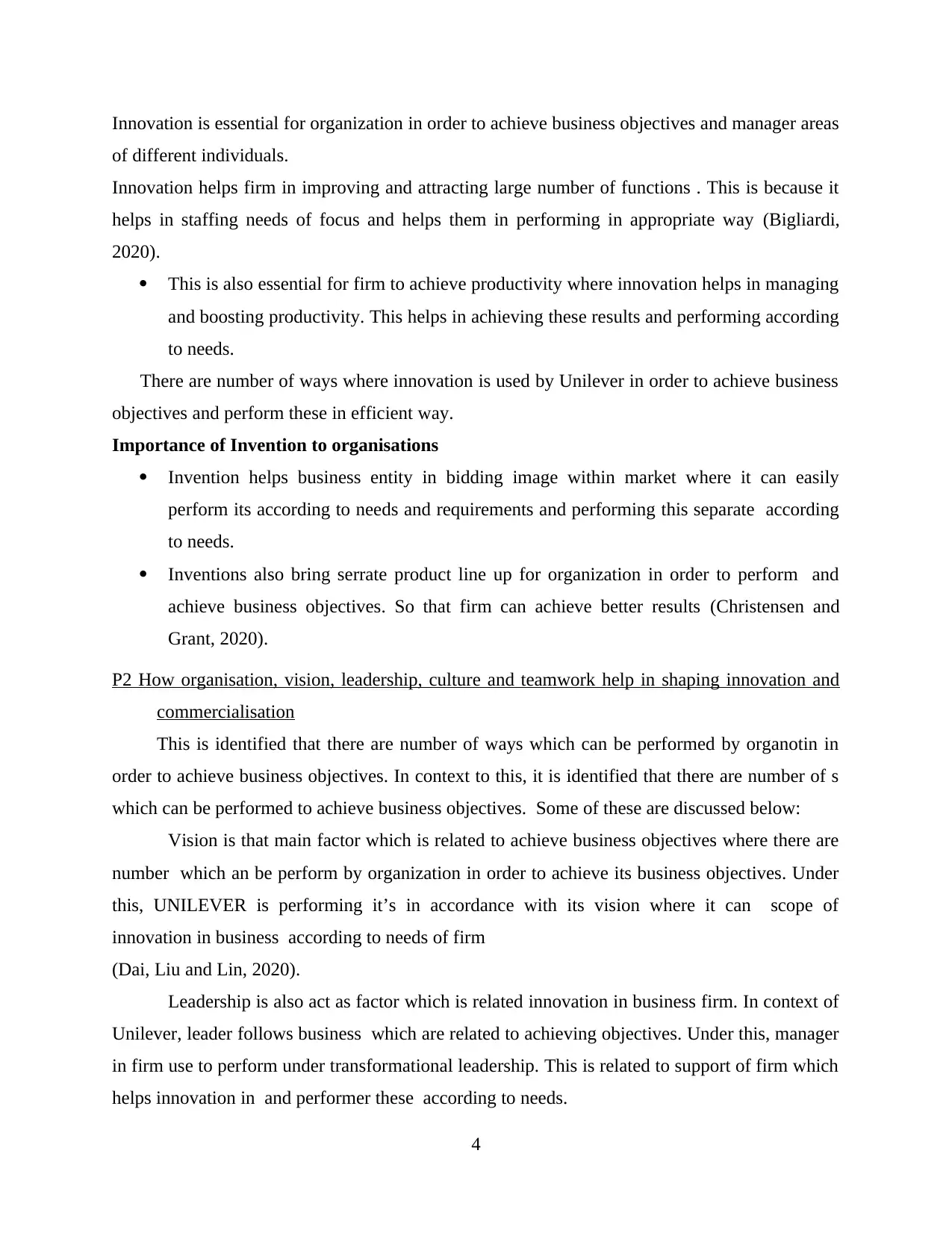
Innovation is essential for organization in order to achieve business objectives and manager areas
of different individuals.
Innovation helps firm in improving and attracting large number of functions . This is because it
helps in staffing needs of focus and helps them in performing in appropriate way (Bigliardi,
2020).
This is also essential for firm to achieve productivity where innovation helps in managing
and boosting productivity. This helps in achieving these results and performing according
to needs.
There are number of ways where innovation is used by Unilever in order to achieve business
objectives and perform these in efficient way.
Importance of Invention to organisations
Invention helps business entity in bidding image within market where it can easily
perform its according to needs and requirements and performing this separate according
to needs.
Inventions also bring serrate product line up for organization in order to perform and
achieve business objectives. So that firm can achieve better results (Christensen and
Grant, 2020).
P2 How organisation, vision, leadership, culture and teamwork help in shaping innovation and
commercialisation
This is identified that there are number of ways which can be performed by organotin in
order to achieve business objectives. In context to this, it is identified that there are number of s
which can be performed to achieve business objectives. Some of these are discussed below:
Vision is that main factor which is related to achieve business objectives where there are
number which an be perform by organization in order to achieve its business objectives. Under
this, UNILEVER is performing it’s in accordance with its vision where it can scope of
innovation in business according to needs of firm
(Dai, Liu and Lin, 2020).
Leadership is also act as factor which is related innovation in business firm. In context of
Unilever, leader follows business which are related to achieving objectives. Under this, manager
in firm use to perform under transformational leadership. This is related to support of firm which
helps innovation in and performer these according to needs.
4
of different individuals.
Innovation helps firm in improving and attracting large number of functions . This is because it
helps in staffing needs of focus and helps them in performing in appropriate way (Bigliardi,
2020).
This is also essential for firm to achieve productivity where innovation helps in managing
and boosting productivity. This helps in achieving these results and performing according
to needs.
There are number of ways where innovation is used by Unilever in order to achieve business
objectives and perform these in efficient way.
Importance of Invention to organisations
Invention helps business entity in bidding image within market where it can easily
perform its according to needs and requirements and performing this separate according
to needs.
Inventions also bring serrate product line up for organization in order to perform and
achieve business objectives. So that firm can achieve better results (Christensen and
Grant, 2020).
P2 How organisation, vision, leadership, culture and teamwork help in shaping innovation and
commercialisation
This is identified that there are number of ways which can be performed by organotin in
order to achieve business objectives. In context to this, it is identified that there are number of s
which can be performed to achieve business objectives. Some of these are discussed below:
Vision is that main factor which is related to achieve business objectives where there are
number which an be perform by organization in order to achieve its business objectives. Under
this, UNILEVER is performing it’s in accordance with its vision where it can scope of
innovation in business according to needs of firm
(Dai, Liu and Lin, 2020).
Leadership is also act as factor which is related innovation in business firm. In context of
Unilever, leader follows business which are related to achieving objectives. Under this, manager
in firm use to perform under transformational leadership. This is related to support of firm which
helps innovation in and performer these according to needs.
4
Paraphrase This Document
Need a fresh take? Get an instant paraphrase of this document with our AI Paraphraser
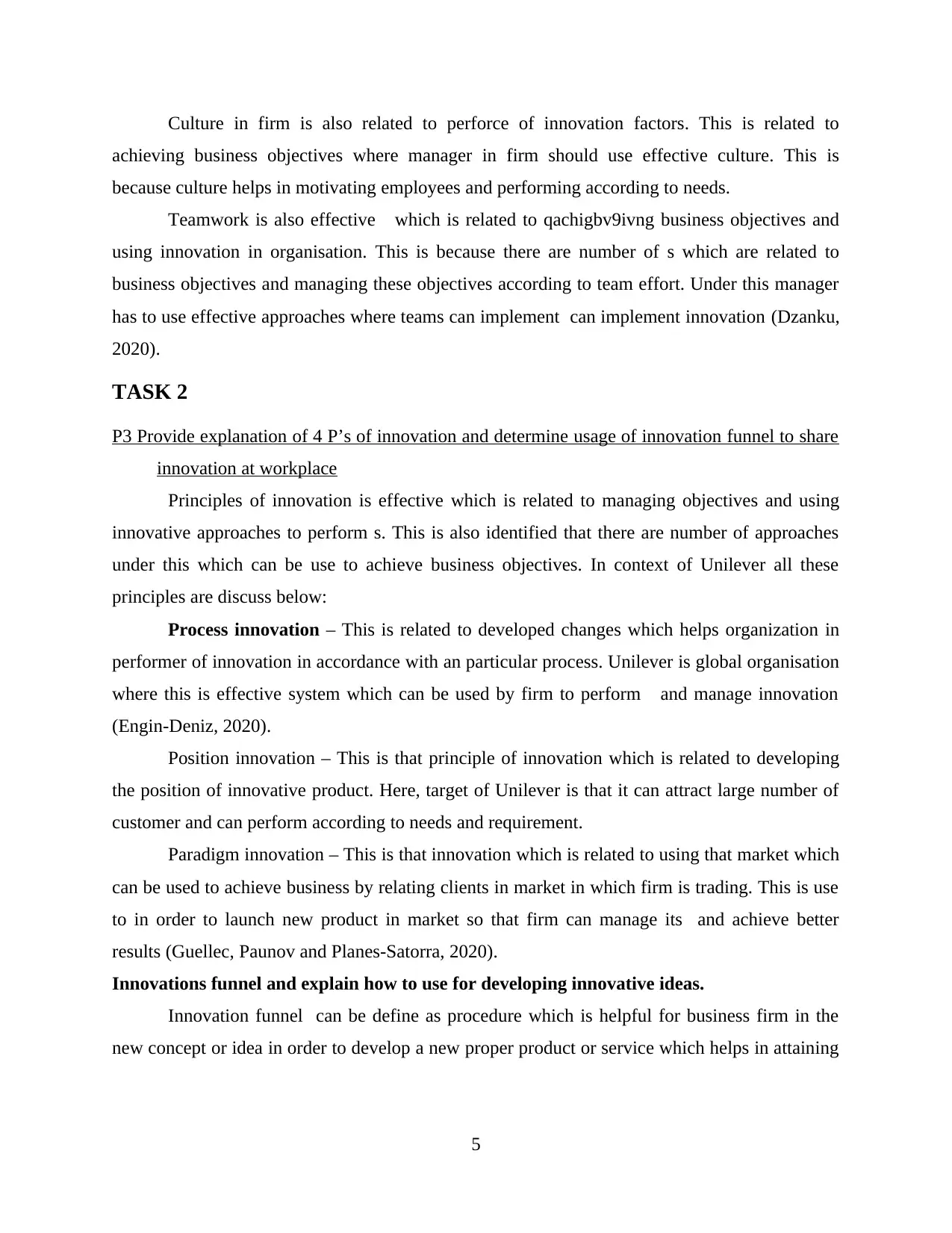
Culture in firm is also related to perforce of innovation factors. This is related to
achieving business objectives where manager in firm should use effective culture. This is
because culture helps in motivating employees and performing according to needs.
Teamwork is also effective which is related to qachigbv9ivng business objectives and
using innovation in organisation. This is because there are number of s which are related to
business objectives and managing these objectives according to team effort. Under this manager
has to use effective approaches where teams can implement can implement innovation (Dzanku,
2020).
TASK 2
P3 Provide explanation of 4 P’s of innovation and determine usage of innovation funnel to share
innovation at workplace
Principles of innovation is effective which is related to managing objectives and using
innovative approaches to perform s. This is also identified that there are number of approaches
under this which can be use to achieve business objectives. In context of Unilever all these
principles are discuss below:
Process innovation – This is related to developed changes which helps organization in
performer of innovation in accordance with an particular process. Unilever is global organisation
where this is effective system which can be used by firm to perform and manage innovation
(Engin-Deniz, 2020).
Position innovation – This is that principle of innovation which is related to developing
the position of innovative product. Here, target of Unilever is that it can attract large number of
customer and can perform according to needs and requirement.
Paradigm innovation – This is that innovation which is related to using that market which
can be used to achieve business by relating clients in market in which firm is trading. This is use
to in order to launch new product in market so that firm can manage its and achieve better
results (Guellec, Paunov and Planes-Satorra, 2020).
Innovations funnel and explain how to use for developing innovative ideas.
Innovation funnel can be define as procedure which is helpful for business firm in the
new concept or idea in order to develop a new proper product or service which helps in attaining
5
achieving business objectives where manager in firm should use effective culture. This is
because culture helps in motivating employees and performing according to needs.
Teamwork is also effective which is related to qachigbv9ivng business objectives and
using innovation in organisation. This is because there are number of s which are related to
business objectives and managing these objectives according to team effort. Under this manager
has to use effective approaches where teams can implement can implement innovation (Dzanku,
2020).
TASK 2
P3 Provide explanation of 4 P’s of innovation and determine usage of innovation funnel to share
innovation at workplace
Principles of innovation is effective which is related to managing objectives and using
innovative approaches to perform s. This is also identified that there are number of approaches
under this which can be use to achieve business objectives. In context of Unilever all these
principles are discuss below:
Process innovation – This is related to developed changes which helps organization in
performer of innovation in accordance with an particular process. Unilever is global organisation
where this is effective system which can be used by firm to perform and manage innovation
(Engin-Deniz, 2020).
Position innovation – This is that principle of innovation which is related to developing
the position of innovative product. Here, target of Unilever is that it can attract large number of
customer and can perform according to needs and requirement.
Paradigm innovation – This is that innovation which is related to using that market which
can be used to achieve business by relating clients in market in which firm is trading. This is use
to in order to launch new product in market so that firm can manage its and achieve better
results (Guellec, Paunov and Planes-Satorra, 2020).
Innovations funnel and explain how to use for developing innovative ideas.
Innovation funnel can be define as procedure which is helpful for business firm in the
new concept or idea in order to develop a new proper product or service which helps in attaining
5
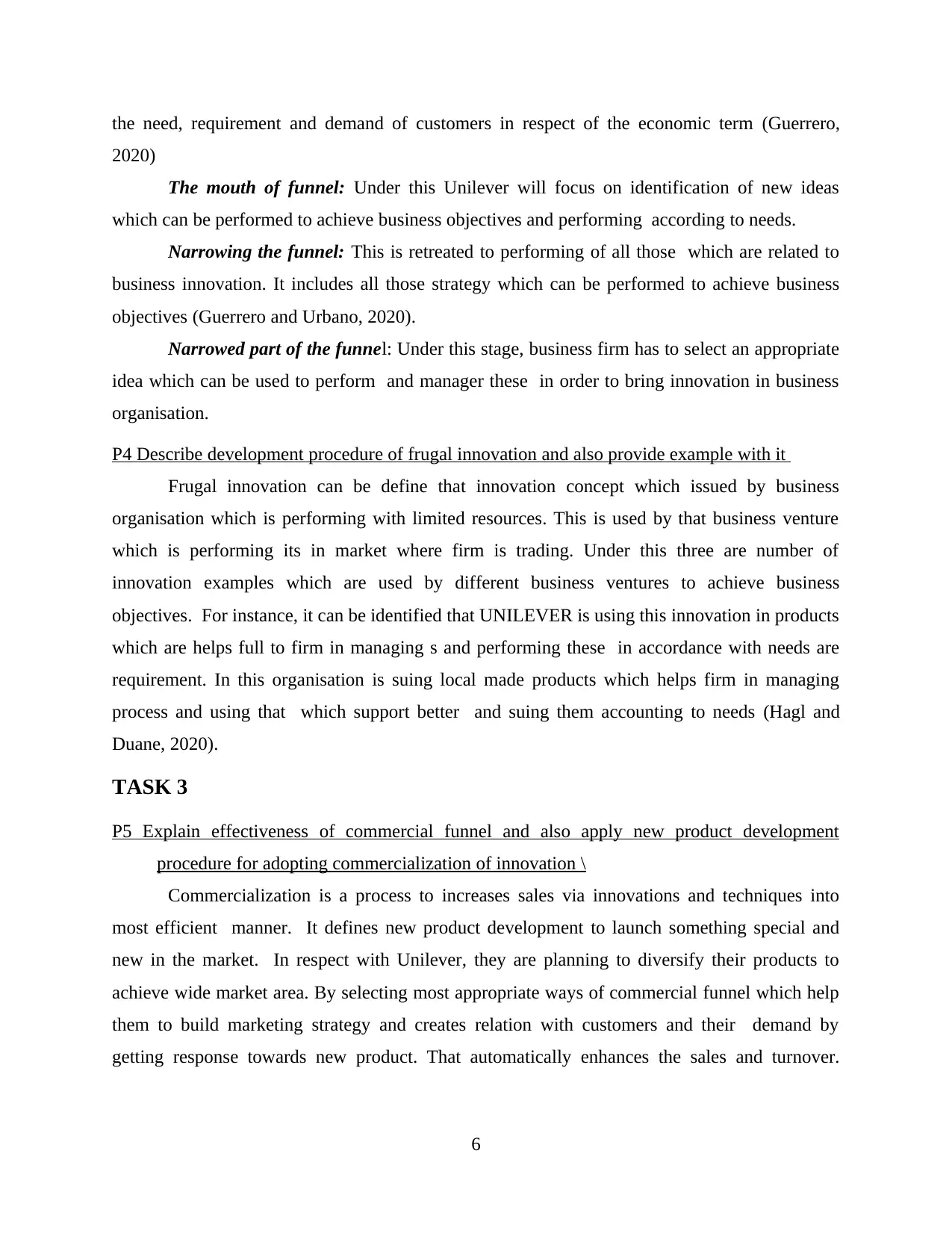
the need, requirement and demand of customers in respect of the economic term (Guerrero,
2020)
The mouth of funnel: Under this Unilever will focus on identification of new ideas
which can be performed to achieve business objectives and performing according to needs.
Narrowing the funnel: This is retreated to performing of all those which are related to
business innovation. It includes all those strategy which can be performed to achieve business
objectives (Guerrero and Urbano, 2020).
Narrowed part of the funnel: Under this stage, business firm has to select an appropriate
idea which can be used to perform and manager these in order to bring innovation in business
organisation.
P4 Describe development procedure of frugal innovation and also provide example with it
Frugal innovation can be define that innovation concept which issued by business
organisation which is performing with limited resources. This is used by that business venture
which is performing its in market where firm is trading. Under this three are number of
innovation examples which are used by different business ventures to achieve business
objectives. For instance, it can be identified that UNILEVER is using this innovation in products
which are helps full to firm in managing s and performing these in accordance with needs are
requirement. In this organisation is suing local made products which helps firm in managing
process and using that which support better and suing them accounting to needs (Hagl and
Duane, 2020).
TASK 3
P5 Explain effectiveness of commercial funnel and also apply new product development
procedure for adopting commercialization of innovation \
Commercialization is a process to increases sales via innovations and techniques into
most efficient manner. It defines new product development to launch something special and
new in the market. In respect with Unilever, they are planning to diversify their products to
achieve wide market area. By selecting most appropriate ways of commercial funnel which help
them to build marketing strategy and creates relation with customers and their demand by
getting response towards new product. That automatically enhances the sales and turnover.
6
2020)
The mouth of funnel: Under this Unilever will focus on identification of new ideas
which can be performed to achieve business objectives and performing according to needs.
Narrowing the funnel: This is retreated to performing of all those which are related to
business innovation. It includes all those strategy which can be performed to achieve business
objectives (Guerrero and Urbano, 2020).
Narrowed part of the funnel: Under this stage, business firm has to select an appropriate
idea which can be used to perform and manager these in order to bring innovation in business
organisation.
P4 Describe development procedure of frugal innovation and also provide example with it
Frugal innovation can be define that innovation concept which issued by business
organisation which is performing with limited resources. This is used by that business venture
which is performing its in market where firm is trading. Under this three are number of
innovation examples which are used by different business ventures to achieve business
objectives. For instance, it can be identified that UNILEVER is using this innovation in products
which are helps full to firm in managing s and performing these in accordance with needs are
requirement. In this organisation is suing local made products which helps firm in managing
process and using that which support better and suing them accounting to needs (Hagl and
Duane, 2020).
TASK 3
P5 Explain effectiveness of commercial funnel and also apply new product development
procedure for adopting commercialization of innovation \
Commercialization is a process to increases sales via innovations and techniques into
most efficient manner. It defines new product development to launch something special and
new in the market. In respect with Unilever, they are planning to diversify their products to
achieve wide market area. By selecting most appropriate ways of commercial funnel which help
them to build marketing strategy and creates relation with customers and their demand by
getting response towards new product. That automatically enhances the sales and turnover.
6
⊘ This is a preview!⊘
Do you want full access?
Subscribe today to unlock all pages.

Trusted by 1+ million students worldwide
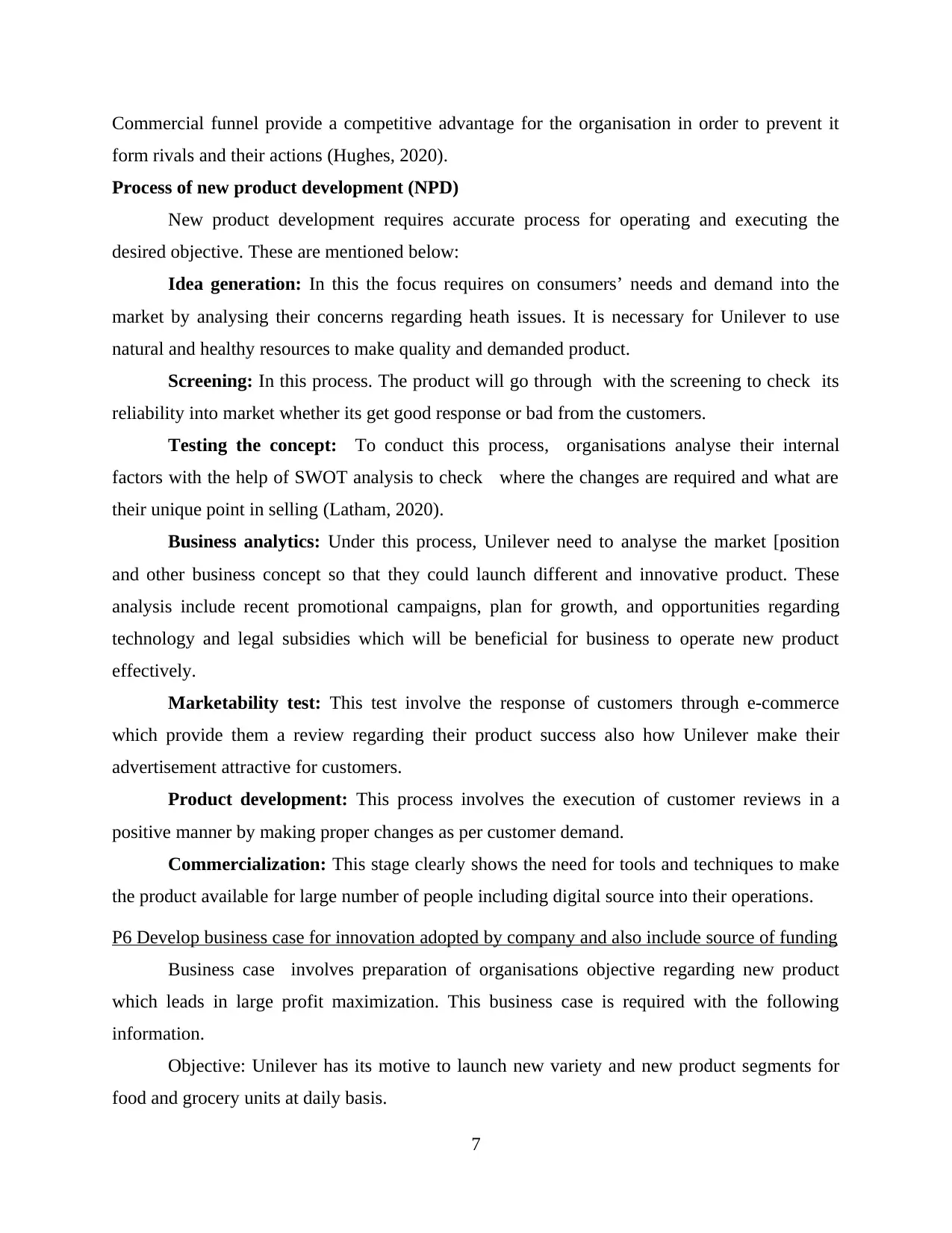
Commercial funnel provide a competitive advantage for the organisation in order to prevent it
form rivals and their actions (Hughes, 2020).
Process of new product development (NPD)
New product development requires accurate process for operating and executing the
desired objective. These are mentioned below:
Idea generation: In this the focus requires on consumers’ needs and demand into the
market by analysing their concerns regarding heath issues. It is necessary for Unilever to use
natural and healthy resources to make quality and demanded product.
Screening: In this process. The product will go through with the screening to check its
reliability into market whether its get good response or bad from the customers.
Testing the concept: To conduct this process, organisations analyse their internal
factors with the help of SWOT analysis to check where the changes are required and what are
their unique point in selling (Latham, 2020).
Business analytics: Under this process, Unilever need to analyse the market [position
and other business concept so that they could launch different and innovative product. These
analysis include recent promotional campaigns, plan for growth, and opportunities regarding
technology and legal subsidies which will be beneficial for business to operate new product
effectively.
Marketability test: This test involve the response of customers through e-commerce
which provide them a review regarding their product success also how Unilever make their
advertisement attractive for customers.
Product development: This process involves the execution of customer reviews in a
positive manner by making proper changes as per customer demand.
Commercialization: This stage clearly shows the need for tools and techniques to make
the product available for large number of people including digital source into their operations.
P6 Develop business case for innovation adopted by company and also include source of funding
Business case involves preparation of organisations objective regarding new product
which leads in large profit maximization. This business case is required with the following
information.
Objective: Unilever has its motive to launch new variety and new product segments for
food and grocery units at daily basis.
7
form rivals and their actions (Hughes, 2020).
Process of new product development (NPD)
New product development requires accurate process for operating and executing the
desired objective. These are mentioned below:
Idea generation: In this the focus requires on consumers’ needs and demand into the
market by analysing their concerns regarding heath issues. It is necessary for Unilever to use
natural and healthy resources to make quality and demanded product.
Screening: In this process. The product will go through with the screening to check its
reliability into market whether its get good response or bad from the customers.
Testing the concept: To conduct this process, organisations analyse their internal
factors with the help of SWOT analysis to check where the changes are required and what are
their unique point in selling (Latham, 2020).
Business analytics: Under this process, Unilever need to analyse the market [position
and other business concept so that they could launch different and innovative product. These
analysis include recent promotional campaigns, plan for growth, and opportunities regarding
technology and legal subsidies which will be beneficial for business to operate new product
effectively.
Marketability test: This test involve the response of customers through e-commerce
which provide them a review regarding their product success also how Unilever make their
advertisement attractive for customers.
Product development: This process involves the execution of customer reviews in a
positive manner by making proper changes as per customer demand.
Commercialization: This stage clearly shows the need for tools and techniques to make
the product available for large number of people including digital source into their operations.
P6 Develop business case for innovation adopted by company and also include source of funding
Business case involves preparation of organisations objective regarding new product
which leads in large profit maximization. This business case is required with the following
information.
Objective: Unilever has its motive to launch new variety and new product segments for
food and grocery units at daily basis.
7
Paraphrase This Document
Need a fresh take? Get an instant paraphrase of this document with our AI Paraphraser
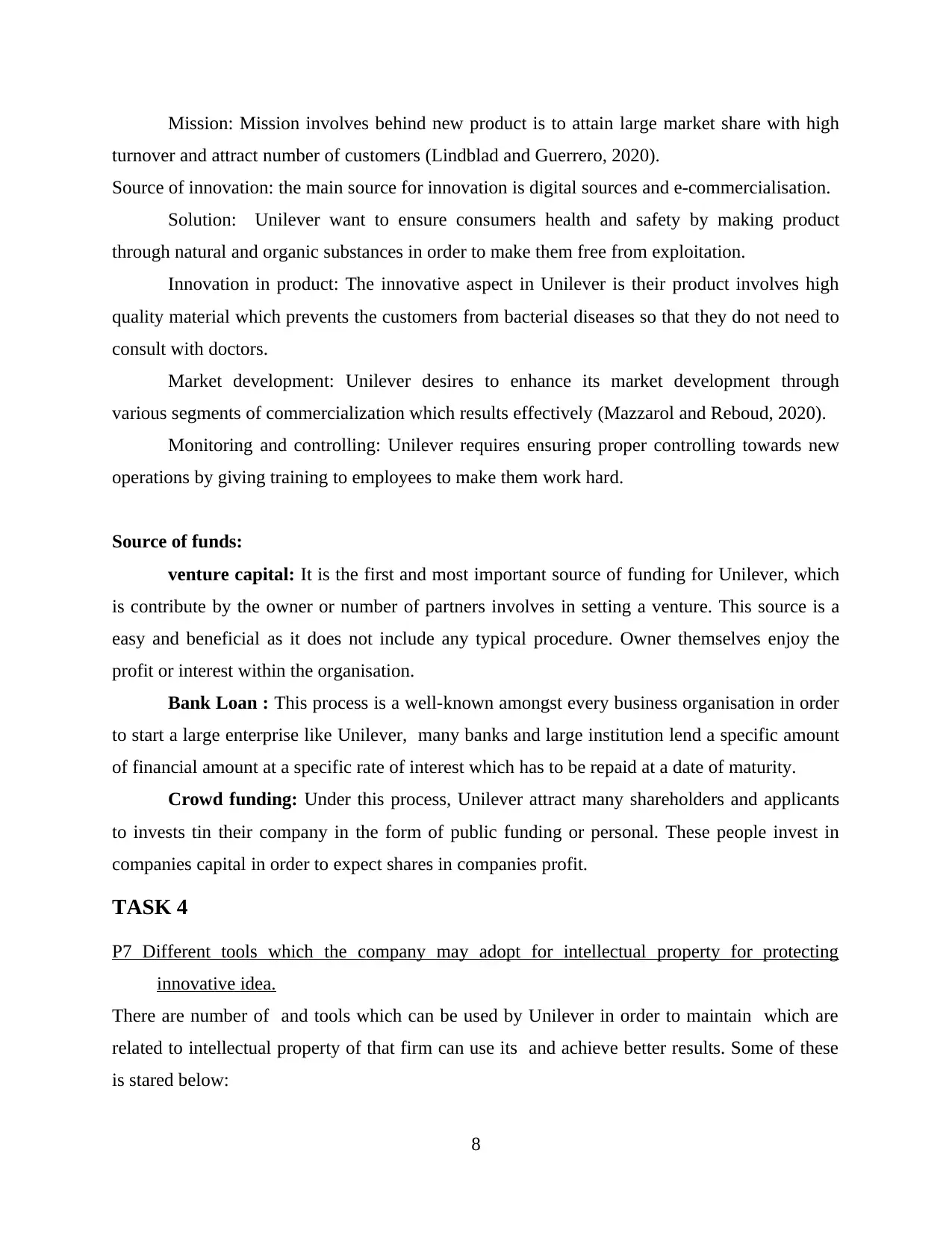
Mission: Mission involves behind new product is to attain large market share with high
turnover and attract number of customers (Lindblad and Guerrero, 2020).
Source of innovation: the main source for innovation is digital sources and e-commercialisation.
Solution: Unilever want to ensure consumers health and safety by making product
through natural and organic substances in order to make them free from exploitation.
Innovation in product: The innovative aspect in Unilever is their product involves high
quality material which prevents the customers from bacterial diseases so that they do not need to
consult with doctors.
Market development: Unilever desires to enhance its market development through
various segments of commercialization which results effectively (Mazzarol and Reboud, 2020).
Monitoring and controlling: Unilever requires ensuring proper controlling towards new
operations by giving training to employees to make them work hard.
Source of funds:
venture capital: It is the first and most important source of funding for Unilever, which
is contribute by the owner or number of partners involves in setting a venture. This source is a
easy and beneficial as it does not include any typical procedure. Owner themselves enjoy the
profit or interest within the organisation.
Bank Loan : This process is a well-known amongst every business organisation in order
to start a large enterprise like Unilever, many banks and large institution lend a specific amount
of financial amount at a specific rate of interest which has to be repaid at a date of maturity.
Crowd funding: Under this process, Unilever attract many shareholders and applicants
to invests tin their company in the form of public funding or personal. These people invest in
companies capital in order to expect shares in companies profit.
TASK 4
P7 Different tools which the company may adopt for intellectual property for protecting
innovative idea.
There are number of and tools which can be used by Unilever in order to maintain which are
related to intellectual property of that firm can use its and achieve better results. Some of these
is stared below:
8
turnover and attract number of customers (Lindblad and Guerrero, 2020).
Source of innovation: the main source for innovation is digital sources and e-commercialisation.
Solution: Unilever want to ensure consumers health and safety by making product
through natural and organic substances in order to make them free from exploitation.
Innovation in product: The innovative aspect in Unilever is their product involves high
quality material which prevents the customers from bacterial diseases so that they do not need to
consult with doctors.
Market development: Unilever desires to enhance its market development through
various segments of commercialization which results effectively (Mazzarol and Reboud, 2020).
Monitoring and controlling: Unilever requires ensuring proper controlling towards new
operations by giving training to employees to make them work hard.
Source of funds:
venture capital: It is the first and most important source of funding for Unilever, which
is contribute by the owner or number of partners involves in setting a venture. This source is a
easy and beneficial as it does not include any typical procedure. Owner themselves enjoy the
profit or interest within the organisation.
Bank Loan : This process is a well-known amongst every business organisation in order
to start a large enterprise like Unilever, many banks and large institution lend a specific amount
of financial amount at a specific rate of interest which has to be repaid at a date of maturity.
Crowd funding: Under this process, Unilever attract many shareholders and applicants
to invests tin their company in the form of public funding or personal. These people invest in
companies capital in order to expect shares in companies profit.
TASK 4
P7 Different tools which the company may adopt for intellectual property for protecting
innovative idea.
There are number of and tools which can be used by Unilever in order to maintain which are
related to intellectual property of that firm can use its and achieve better results. Some of these
is stared below:
8
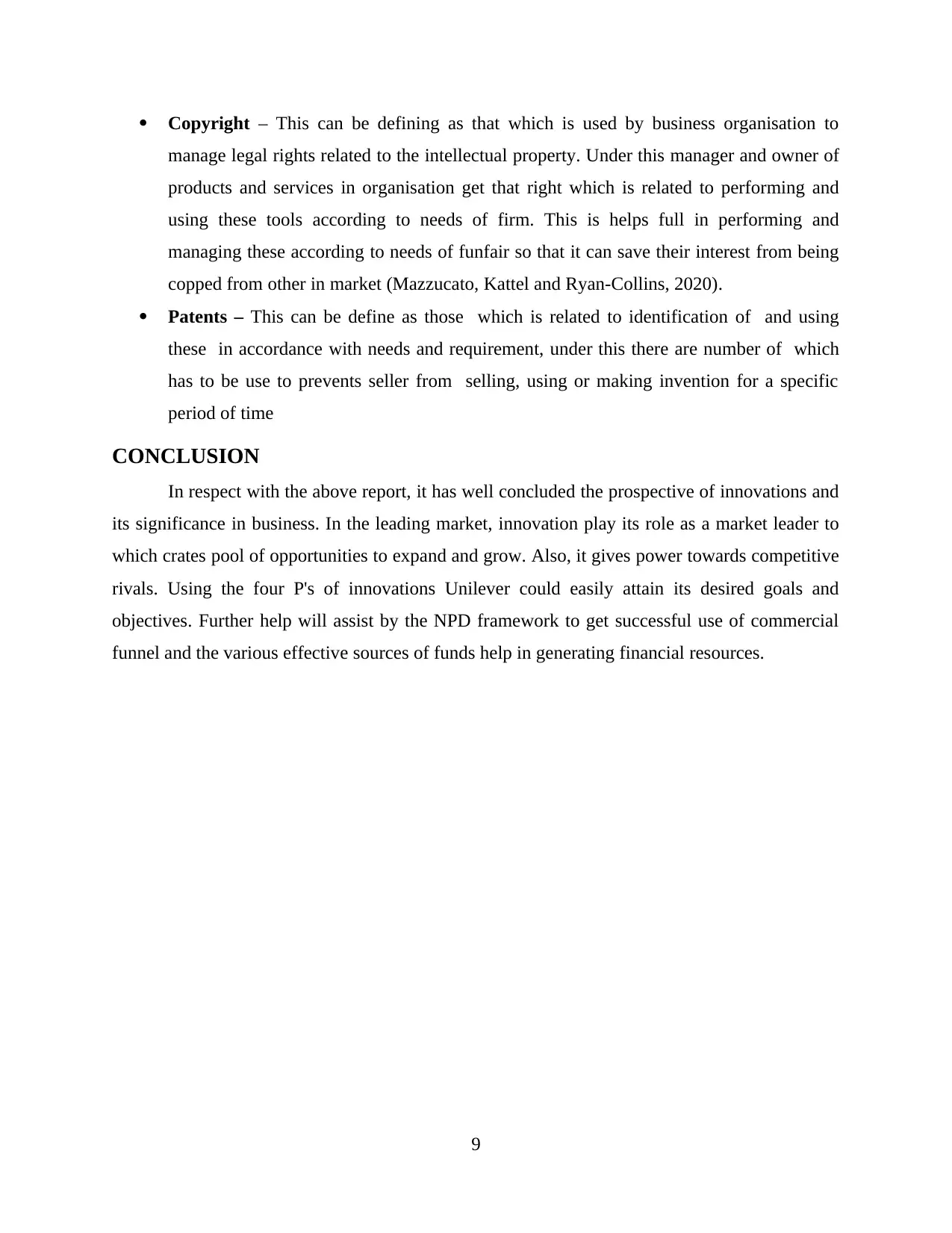
Copyright – This can be defining as that which is used by business organisation to
manage legal rights related to the intellectual property. Under this manager and owner of
products and services in organisation get that right which is related to performing and
using these tools according to needs of firm. This is helps full in performing and
managing these according to needs of funfair so that it can save their interest from being
copped from other in market (Mazzucato, Kattel and Ryan-Collins, 2020).
Patents – This can be define as those which is related to identification of and using
these in accordance with needs and requirement, under this there are number of which
has to be use to prevents seller from selling, using or making invention for a specific
period of time
CONCLUSION
In respect with the above report, it has well concluded the prospective of innovations and
its significance in business. In the leading market, innovation play its role as a market leader to
which crates pool of opportunities to expand and grow. Also, it gives power towards competitive
rivals. Using the four P's of innovations Unilever could easily attain its desired goals and
objectives. Further help will assist by the NPD framework to get successful use of commercial
funnel and the various effective sources of funds help in generating financial resources.
9
manage legal rights related to the intellectual property. Under this manager and owner of
products and services in organisation get that right which is related to performing and
using these tools according to needs of firm. This is helps full in performing and
managing these according to needs of funfair so that it can save their interest from being
copped from other in market (Mazzucato, Kattel and Ryan-Collins, 2020).
Patents – This can be define as those which is related to identification of and using
these in accordance with needs and requirement, under this there are number of which
has to be use to prevents seller from selling, using or making invention for a specific
period of time
CONCLUSION
In respect with the above report, it has well concluded the prospective of innovations and
its significance in business. In the leading market, innovation play its role as a market leader to
which crates pool of opportunities to expand and grow. Also, it gives power towards competitive
rivals. Using the four P's of innovations Unilever could easily attain its desired goals and
objectives. Further help will assist by the NPD framework to get successful use of commercial
funnel and the various effective sources of funds help in generating financial resources.
9
⊘ This is a preview!⊘
Do you want full access?
Subscribe today to unlock all pages.

Trusted by 1+ million students worldwide
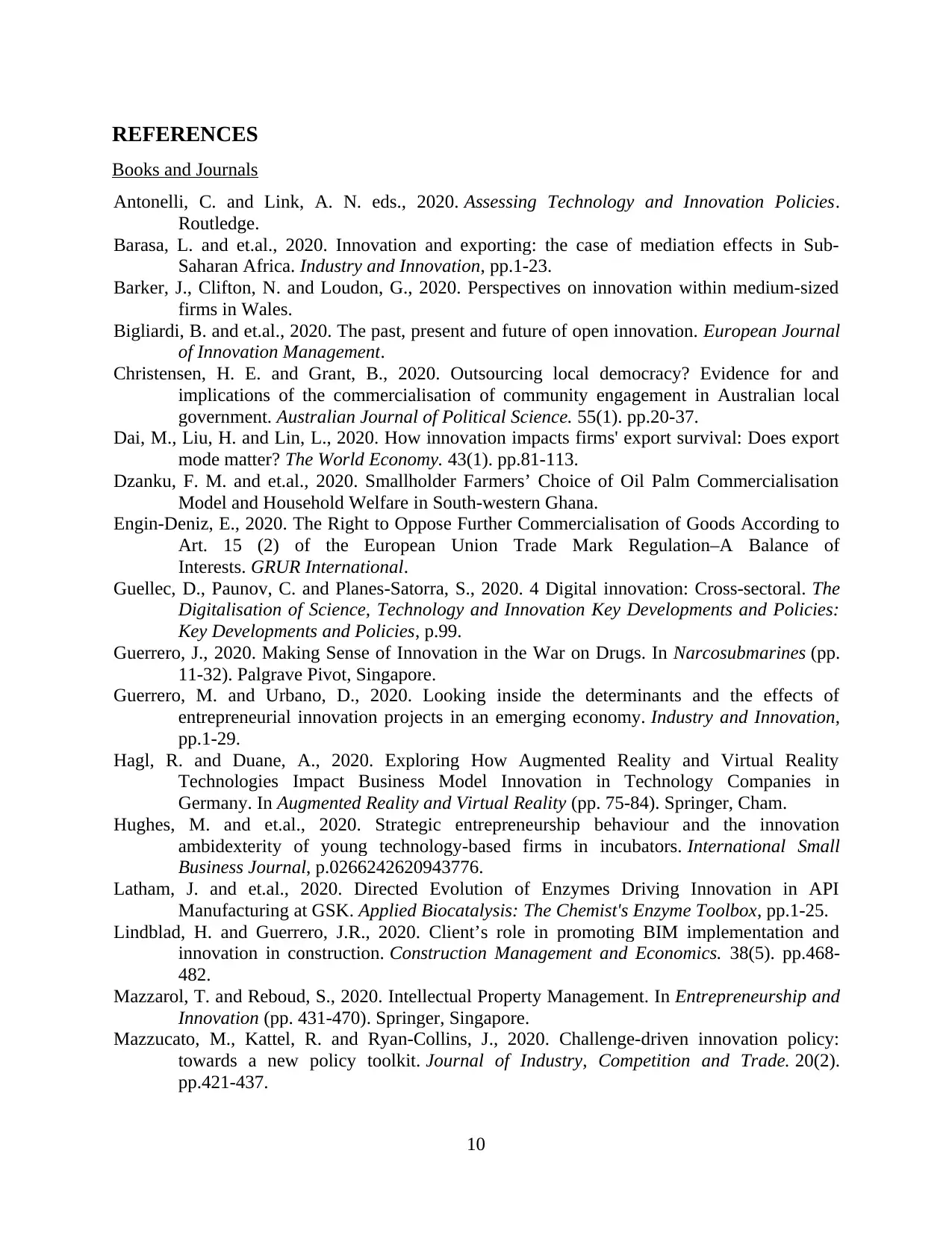
REFERENCES
Books and Journals
Antonelli, C. and Link, A. N. eds., 2020. Assessing Technology and Innovation Policies.
Routledge.
Barasa, L. and et.al., 2020. Innovation and exporting: the case of mediation effects in Sub-
Saharan Africa. Industry and Innovation, pp.1-23.
Barker, J., Clifton, N. and Loudon, G., 2020. Perspectives on innovation within medium-sized
firms in Wales.
Bigliardi, B. and et.al., 2020. The past, present and future of open innovation. European Journal
of Innovation Management.
Christensen, H. E. and Grant, B., 2020. Outsourcing local democracy? Evidence for and
implications of the commercialisation of community engagement in Australian local
government. Australian Journal of Political Science. 55(1). pp.20-37.
Dai, M., Liu, H. and Lin, L., 2020. How innovation impacts firms' export survival: Does export
mode matter? The World Economy. 43(1). pp.81-113.
Dzanku, F. M. and et.al., 2020. Smallholder Farmers’ Choice of Oil Palm Commercialisation
Model and Household Welfare in South-western Ghana.
Engin-Deniz, E., 2020. The Right to Oppose Further Commercialisation of Goods According to
Art. 15 (2) of the European Union Trade Mark Regulation‒A Balance of
Interests. GRUR International.
Guellec, D., Paunov, C. and Planes-Satorra, S., 2020. 4 Digital innovation: Cross-sectoral. The
Digitalisation of Science, Technology and Innovation Key Developments and Policies:
Key Developments and Policies, p.99.
Guerrero, J., 2020. Making Sense of Innovation in the War on Drugs. In Narcosubmarines (pp.
11-32). Palgrave Pivot, Singapore.
Guerrero, M. and Urbano, D., 2020. Looking inside the determinants and the effects of
entrepreneurial innovation projects in an emerging economy. Industry and Innovation,
pp.1-29.
Hagl, R. and Duane, A., 2020. Exploring How Augmented Reality and Virtual Reality
Technologies Impact Business Model Innovation in Technology Companies in
Germany. In Augmented Reality and Virtual Reality (pp. 75-84). Springer, Cham.
Hughes, M. and et.al., 2020. Strategic entrepreneurship behaviour and the innovation
ambidexterity of young technology-based firms in incubators. International Small
Business Journal, p.0266242620943776.
Latham, J. and et.al., 2020. Directed Evolution of Enzymes Driving Innovation in API
Manufacturing at GSK. Applied Biocatalysis: The Chemist's Enzyme Toolbox, pp.1-25.
Lindblad, H. and Guerrero, J.R., 2020. Client’s role in promoting BIM implementation and
innovation in construction. Construction Management and Economics. 38(5). pp.468-
482.
Mazzarol, T. and Reboud, S., 2020. Intellectual Property Management. In Entrepreneurship and
Innovation (pp. 431-470). Springer, Singapore.
Mazzucato, M., Kattel, R. and Ryan-Collins, J., 2020. Challenge-driven innovation policy:
towards a new policy toolkit. Journal of Industry, Competition and Trade. 20(2).
pp.421-437.
10
Books and Journals
Antonelli, C. and Link, A. N. eds., 2020. Assessing Technology and Innovation Policies.
Routledge.
Barasa, L. and et.al., 2020. Innovation and exporting: the case of mediation effects in Sub-
Saharan Africa. Industry and Innovation, pp.1-23.
Barker, J., Clifton, N. and Loudon, G., 2020. Perspectives on innovation within medium-sized
firms in Wales.
Bigliardi, B. and et.al., 2020. The past, present and future of open innovation. European Journal
of Innovation Management.
Christensen, H. E. and Grant, B., 2020. Outsourcing local democracy? Evidence for and
implications of the commercialisation of community engagement in Australian local
government. Australian Journal of Political Science. 55(1). pp.20-37.
Dai, M., Liu, H. and Lin, L., 2020. How innovation impacts firms' export survival: Does export
mode matter? The World Economy. 43(1). pp.81-113.
Dzanku, F. M. and et.al., 2020. Smallholder Farmers’ Choice of Oil Palm Commercialisation
Model and Household Welfare in South-western Ghana.
Engin-Deniz, E., 2020. The Right to Oppose Further Commercialisation of Goods According to
Art. 15 (2) of the European Union Trade Mark Regulation‒A Balance of
Interests. GRUR International.
Guellec, D., Paunov, C. and Planes-Satorra, S., 2020. 4 Digital innovation: Cross-sectoral. The
Digitalisation of Science, Technology and Innovation Key Developments and Policies:
Key Developments and Policies, p.99.
Guerrero, J., 2020. Making Sense of Innovation in the War on Drugs. In Narcosubmarines (pp.
11-32). Palgrave Pivot, Singapore.
Guerrero, M. and Urbano, D., 2020. Looking inside the determinants and the effects of
entrepreneurial innovation projects in an emerging economy. Industry and Innovation,
pp.1-29.
Hagl, R. and Duane, A., 2020. Exploring How Augmented Reality and Virtual Reality
Technologies Impact Business Model Innovation in Technology Companies in
Germany. In Augmented Reality and Virtual Reality (pp. 75-84). Springer, Cham.
Hughes, M. and et.al., 2020. Strategic entrepreneurship behaviour and the innovation
ambidexterity of young technology-based firms in incubators. International Small
Business Journal, p.0266242620943776.
Latham, J. and et.al., 2020. Directed Evolution of Enzymes Driving Innovation in API
Manufacturing at GSK. Applied Biocatalysis: The Chemist's Enzyme Toolbox, pp.1-25.
Lindblad, H. and Guerrero, J.R., 2020. Client’s role in promoting BIM implementation and
innovation in construction. Construction Management and Economics. 38(5). pp.468-
482.
Mazzarol, T. and Reboud, S., 2020. Intellectual Property Management. In Entrepreneurship and
Innovation (pp. 431-470). Springer, Singapore.
Mazzucato, M., Kattel, R. and Ryan-Collins, J., 2020. Challenge-driven innovation policy:
towards a new policy toolkit. Journal of Industry, Competition and Trade. 20(2).
pp.421-437.
10
Paraphrase This Document
Need a fresh take? Get an instant paraphrase of this document with our AI Paraphraser

11
1 out of 11
Related Documents
Your All-in-One AI-Powered Toolkit for Academic Success.
+13062052269
info@desklib.com
Available 24*7 on WhatsApp / Email
![[object Object]](/_next/static/media/star-bottom.7253800d.svg)
Unlock your academic potential
Copyright © 2020–2025 A2Z Services. All Rights Reserved. Developed and managed by ZUCOL.




